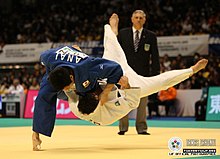
Back Judo Afrikaans Judo ALS Judo AN جودو Arabic جيدو ARY جودو ARZ Yudu AST जूडो AWA Cüdo Azerbaijani جودو AZB
 Kyuzo Mifune (left) and Kanō Jigorō (right) | |
| Focus | Grappling, wrestling, ground fighting |
|---|---|
| Hardness | Full contact |
| Country of origin | Japan |
| Creator | Kanō Jigorō |
| Famous practitioners | See: List of judoka |
| Parenthood | Various koryū Jujutsu schools, principally Tenjin Shin'yō-ryū, Kitō-ryū, and Catch wrestling |
| Ancestor arts |
|
| Descendant arts | Kosen judo, Bartitsu, Yoseikan Budō, Brazilian jiu-jitsu, Sambo, ARB, CQC, Krav Maga, Kapap, Kūdō, MMA, modern Arnis, Luta Livre, shoot wrestling, submission grappling, Vale Tudo |
| Olympic sport |
|
| Official website | |
 Takamasa Anai takes down his opponent during the Grand Slam Tokyo. | |
| Highest governing body | International Judo Federation |
|---|---|
| Characteristics | |
| Contact | Yes |
| Mixed-sex | No |
| Type | Martial art |
| Presence | |
| Country or region | Worldwide |
| Olympic | Debuted in 1964 |
Judo (Japanese: 柔道, Hepburn: Jūdō, lit. 'gentle way') is an unarmed modern Japanese martial art, combat sport, Olympic sport (since 1964), and the most prominent form of jacket wrestling competed internationally.[3][4][5] Judo was created in 1882 by Kanō Jigorō (嘉納 治五郎) as an eclectic martial art, distinguishing itself from its predecessors (primarily Tenjin Shinyo-ryu jujutsu and Kitō-ryū jujutsu) due to an emphasis on "randori" (乱取り, lit. 'free sparring') instead of kata (形, kata, pre-arranged forms) alongside its removal of striking and weapon training elements.[3][4][6] Judo rose to prominence for its dominance over established jujutsu schools in tournaments hosted by the Tokyo Metropolitan Police Department (警視庁武術大会, Keishicho Bujutsu Taikai), resulting in its adoption as the department's primary martial art.[4][3] A judo practitioner is called a "judoka" (柔道家, jūdōka, lit. 'judo performer'), and the judo uniform is called "judogi" (柔道着, jūdōgi, lit. 'judo attire').
The objective of competitive judo is to throw an opponent, immobilize them with a pin, or force an opponent to submit with a joint lock or a choke. While strikes and use of weapons are included in some pre-arranged forms (kata), they are not frequently trained and are illegal in judo competition or free practice.[4] Judo's international governing body is the International Judo Federation, and competitors compete in the international IJF professional circuit.
Judo's philosophy revolves around two primary principles: "Seiryoku-Zenyo" (精力善用, lit. 'good use of energy') and "Jita-Kyoei" (自他共栄, lit. 'mutual welfare and benefit').[4][7][8][9][10] The philosophy and subsequent pedagogy developed for judo became the model for other modern Japanese martial arts that developed from Ko-ryū. Judo has also spawned a number of derivative martial arts around the world, such as Brazilian jiu-jitsu, Krav Maga, sambo, and ARB. Judo also influenced the formation of other combat styles such as close-quarters combat (CQC), mixed martial arts (MMA), shoot wrestling and submission wrestling.
- ^ Inman (2005) p. 10
- ^ The first Olympic competition to award medals to women judoka was in 1992; in 1988, women competed as a demonstration sport. Inman (2005) p. 11
- ^ a b c "Britannica, "Judo"". March 2024.
- ^ a b c d e 『日本大百科全書』電子版【柔道】(CD-ROM version of Encyclopedia Nipponica, "Judo").
- ^ 『日本大百科全書』の最初の定義文(Encyclopedia Nipponica, first phrases, definition of Judo.)「心身を鍛錬することにより、その力をもっとも有効に使用する道であると同時に、人間形成の道である。」
- ^ Cite error: The named reference
:0was invoked but never defined (see the help page). - ^ "Kodokan Judo Institute, "What is Seiryoku-Zenyo?"".
- ^ "Teaching of Kanō Jigorō Shihan" (PDF). Archived (PDF) from the original on October 30, 2021.
- ^ "精力善用、自他共栄を英語で学ぶ". 8 January 2016.
- ^ "Kodokan Judo Institute, "What is Jita-kyoei?"". Archived from the original on 2024-02-18. Retrieved 2021-10-30.